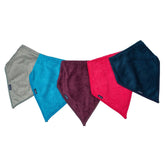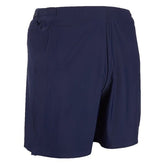Trending Now
Popular Products
Classic Kerchief in Bamboo Towelling
- £11.99
- £11.99
- (-0%)
- Unit price
- / per
-
Teal
-
Burgundy
-
Grey
-
Navy
- Berry
Kes-Vir Men's Swim Wrap Shorts
- £76.99
- £76.99
- (-0%)
- Unit price
- / per
Two Tone Sequin Weighted Lap Pillow
- from £35.99 (£43.19 inc VAT)
- from £35.99 (£43.19 inc VAT)
- (-0%)
- Unit price
- / per
-
Navy
-
Black
-
Pink
Need Help?
Email Us
Choosing the Correct Swimwear
Getting the right swimwear makes swimming more predictable and enjoyable. For some children and young people, reliable continence containment and easier changing are the priorities; for others, it’s comfort and managing sensory load. This guide walks you through fit, features and options so you can choose with confidence.
Safety note: Always follow your pool’s hygiene and containment policy. Some venues require double containment (an inner layer plus an outer containment brief or suit). If you’re unsure about medical considerations, speak to your clinician before swimming.
Who this can help
- Children and young people needing reliable continence containment in the pool
- Those who find changing, water temperature, noise or lighting challenging
- Families, schools and settings wanting quick-dry, wipe-clean, durable kit
Quick wins
- Check venue policy first: confirm if single or double containment is required.
- Practise at home: try the kit in the bath/shower to get used to the feel and seals.
- Pack spares: a second set of swimwear and wipes in a labelled pouch keeps trips calmer.
- One change at a time: introduce new items gradually; praise every step.
How to measure & check the fit
- Measure waist and top of thigh at skin level with a soft tape measure.
- A good containment seal is snug but comfortable — bands lie flat without gaping or digging in.
- Do a quick “seal check” before leaving: run a finger around the waist and leg bands to ensure they’re flat and even.
- If double containment is required, wear the specified inner layer (e.g. reusable or disposable) under the outer brief/suit.
What to choose
1) Containment briefs & suits
- Reusable containment briefs: cost-effective, eco-friendly, and designed to be worn alone or under swimwear.
- Disposable inner briefs: some pools specify a disposable inner layer; carry spares for changes.
- Discreet board shorts / one-piece suits: built-in containment with an everyday look.
2) Comfort & sensory considerations
- Choose soft, chlorine-resistant fabrics and flat seams to reduce irritation.
- Quick-dry layers help with temperature regulation and faster changing.
- Use a short visual sequence for “arrive → change → shower → swim → change → snack”.
3) Coverage & dignity
- Board shorts and one-piece suits can provide more coverage while keeping a typical look.
- Rash tops or UV layers help outdoors and can support modesty if preferred.
Products that can help
Start with these ranges, then pick items that fit age, venue policy and budget. Examples below can be updated as stock changes.
-
Swimwear – containment briefs/shorts, one-piece suits and cover-ups for pool use
- UP360 Reusable Incontinence Swimsters — reusable containment brief worn alone or under swimwear; snug waist and thigh seals.
- Swimsters Disposable Swim Brief — single-use inner layer where venues specify disposable containment.
- Kes-Vir Boys Incontinence Board Shorts — discreet board shorts with integrated containment.
- Hiline Girls Incontinence Swimsuits — girls’ one-piece with built-in containment and chlorine-resistant fabrics.
- UV & quick-dry layers – useful for outdoor sessions and easier post-swim changes
-
Changing kit & carry – make changes quicker and keep wet/dry items separate
- Junior Padded Changing Mat — portable padded mat with wipe-clean surface; folds for travel.
- Care Designs Wet & Dry Bag (Black) — two-compartment bag to separate clean and used items; odour-resistant, wipeable.
- Quiet fidgets – small “busy hands” options for pre-swim waits and changing areas
Care & longevity
- Rinse in cool water after swimming; follow wash instructions to protect elastics and seals.
- Air-dry out of direct heat; avoid fabric softeners that can affect performance fabrics.
- Re-measure regularly; growth changes fit and seal reliability.
Tips for success
- Do a home “seal check” on bands before each swim.
- Pack a spare inner layer and a dry bag for used items.
- Keep language calm and predictable; use the same words each visit.
Troubleshooting
- Leaks: re-check size and seals; smooth the inner layer so it sits flat with no folds.
- Red marks/chafing: bands should be snug, not tight; check seam placement and suit alignment.
- Refusal to wear: introduce in short steps at home (over underwear first), and use a simple reward after practice.
Funding & budgets
- Potential funding options for families
- Digital catalogues to compare options by category
Need advice?
Email enquiries@fledglings.org.uk with age, venue policy (single/double containment), sizes and any sensory considerations. We’ll suggest options that fit your budget. We accept Purchase Orders. UK delivery from £4.99.
Support our work
Donate to Fledglings to help us keep advice free and prices fair.
Related
Last reviewed: 12 September 2025
- Choosing a selection results in a full page refresh.







